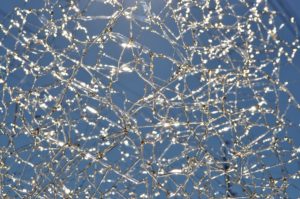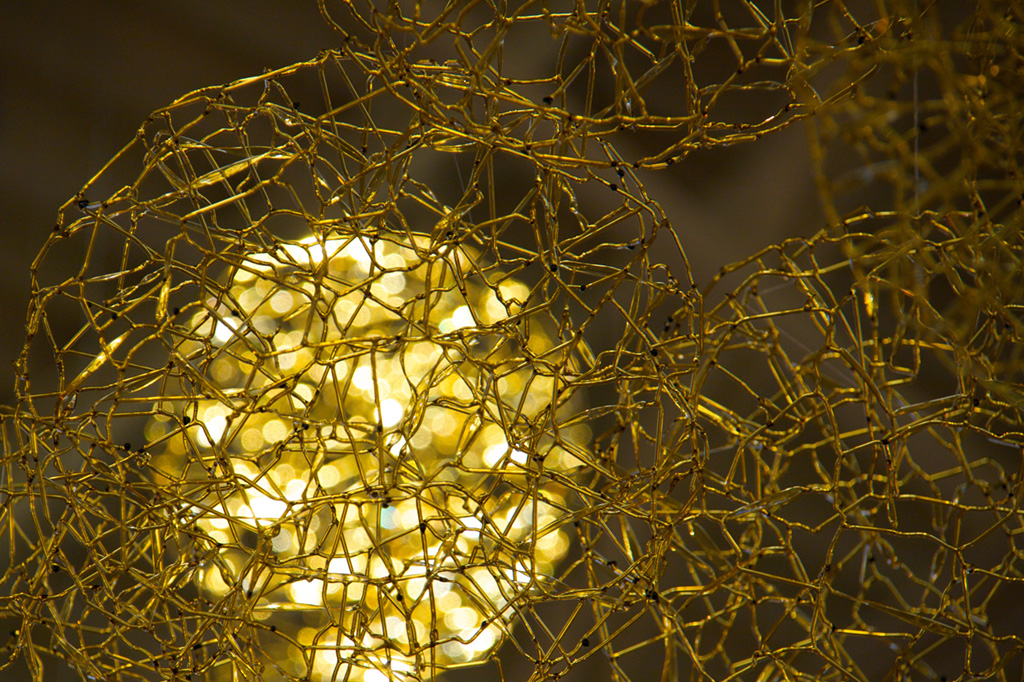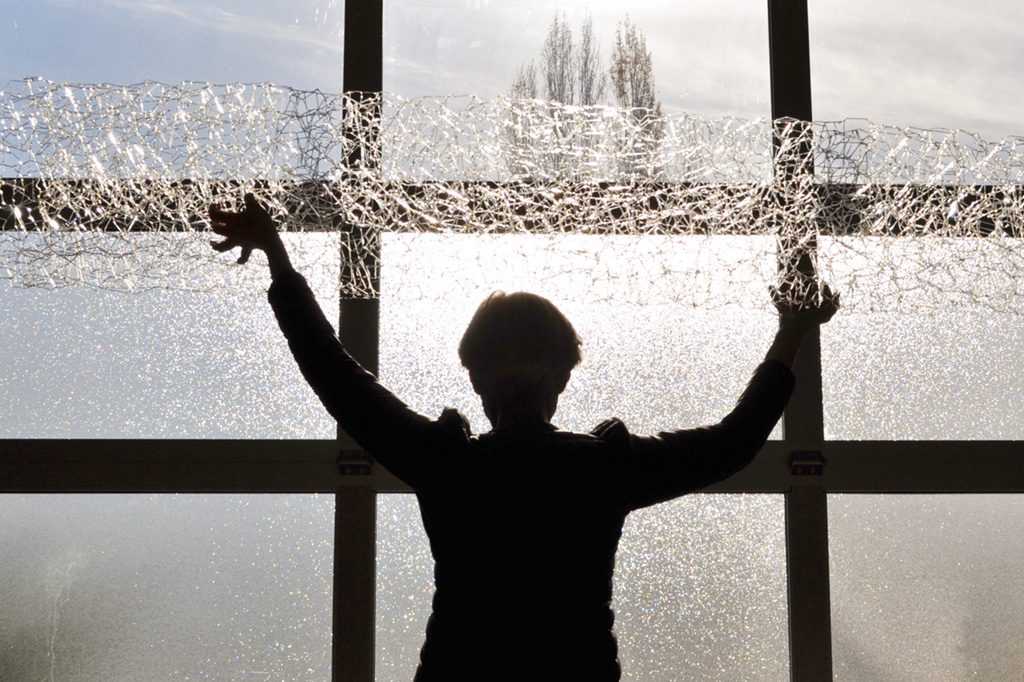We shall have champagne!”
Spoken in a melodic, accented English, this was not an inquiry. Artist Anna Skibska had just given Ketchum gallery owner Andria Friesen and her assistant, Yanna Lantz, a tour of her Seattle studio. Work here was done. And although it is her passion, the place where answered questions are released for others’ consideration, in order to maintain that fervor and fuel her creative hygiene, she needed a change. Home. The place from which hobbies are indulged and outings are plotted.
This does not mean her mind, or personal animation, is bowed, just tempered and redirected. Given license to explore other facets of creativity through mobility.
Her guests will be led to her kitchen where strawberry mice with radish ears and chive tails stare with peppercorn eyes. Soon, they will be consumed whole and chased down with champagne. The host explains the chemical alchemy enhances bubbles.
For Skibska, life with a fevered pitch of a mind means surrendering to its review follicle by follicle. Decimation. Inter-relationships considered. Re-created. Shared with the insight that relationships, while always in flux, demand retelling and re-listening for our personal evolution.
This complex, philosophical artist’s work bridges the worlds of architecture, line drawing and sculpture. With an acetylene torch, Skibska manipulates glass rods into fine, intertwining threads of ethereal forms, translucent, and gravity defying. Her style has been designated a method that must be included in the title of anyone who attempts to employ her techniques. She has exhibited worldwide in museums.
Skibska graduated from the painting program at the Academy of Art in Poland and continued as a professor of fine arts and architecture. She joined the faculty of Washington’s Pilchuck Glass School, teaching also at Pratt Arts Center.
In his 2013 book, “Spark the Creative Flame,” Paul Stankard devoted a chapter to her groundbreaking achievements. The Anna Skibska Flame-Working Studio is where students at Pratt can learn them.
As prestigious as that all is, Skibska describes herself as seriously unserious. And truth be told, even on this fall day when the focus is her winter exhibit coming to Friesen Gallery in Ketchum titled, “Anna Skibska: Light Bearer and Shadow Player,” all she really wants to think about is the pending oyster season.
“Oysters are my weakness! November through the 31st of March, I celebrate.”
The ritual of her oyster obsession, once shared and then compared to her process of her art, gives one a tangible access point to her beautiful mind.
Oysterville, Wash., on the Long Beach Peninsula, is bordered by the Pacific Ocean, Columbia River, and Willapa Bay. The Chinook tribe attracted the first settlers with promises of a never-ending supply of shellfish. The town exploded as new wealth from the California Gold Rush and trade by schooner spread the word about the delectables from the largest estuary in America.
The town once boasted a school, a college, a newspaper, and finally, a church. All picturesque perfection. But the truth included hookers and criminals, drunkards and cheats. Their stories are shared through plaques in front of each of the ghost town structures and cemetery along a walking tour.
“I’m so intrigued by the struggles and betrayals, the uneasy coexistence, the fragility and resilience,” Skibska said. “It’s my own ‘Spoon River Anthologies,’” she laughed, referring to the 1915 Edgar Lee Masters book that raises the dead to rehash the scandalous history of a fictional town. Immediately recognized by readers as authentic, their testimony topples the American myth of the moral superiority of small-town life.
“There is a cannery owned by the same family for generations, and we have an area on the deck reserved for family and friends. We drink champagne and shuck the oysters and throw the shells back to the water.”
Books are her other escape. She prefers to say she lays siege on them, dissecting word by word. On her bedside table now is Olga Tokarczuk’s “Bieguni (Flights),” a nonlinear story series connected over themes of movement and the human body’s preservation. “This is a book to be felt—reading it is highly experiential, full of almost mystical insight,” wrote a
reviewer for World Literature Today.
Skibska could be a character in this novel, which The New Yorker summarized as supporting the idea that “mobility is the engine of creativity.”
But learning how to manage the motion effectively has its roots in Skibska’s history.
As a child, Skibska used her mother’s jewelry as playthings. One day, her mother told her she would have to design her own toys. The jewelry was to be pawned to pay for her terminally ill father’s medical care.
“My answer was I went to the dumpster of a shoe store. I picked the best boxes.
I organized them and I created my theater with different arranged scenes all around. It was so attractive that whoever visited wanted to see Anna’s theater. I felt really great, I felt like the director and I would tell stories and I made it come to life. That’s how I first learned to arrange things and that order was ‘a sacred thing.’”
Because an art career wasn’t as stable as architecture, Skibska was steered toward the latter. It was in that setting she learned about the dichotomy of order and chaos, academic to whimsical. But it was a broken mirror leaned against a dumpster that led her to explore capturing light.

Detail of “Technique” by Anna Skibska at Friesen Gallery, Glass
“The result is truly mesmerizing,” said Friesen Gallery’s Lantz, holding a small intersection of cubes with varying color and refraction, moving it throughout the room to illustrate the variations. “A sculpture will look vastly different in morning light versus twilight. The shadows it makes provide another layer of intrigue.”
It’s afforded a good living, but even if it weren’t, Skibska would be beholden to it.
“I used to have my studio attached to my house, but I couldn’t get away from it.”
A workday begins with a meditation and a 12-minute walk from her condo to the organic grocery midway, where she will buy food for breakfast and lunch.
At work, “I work with the language that I invented to express myself with light. I tell passionately a story. It’s a moment, it’s a sparkle, it’s an impulse. To tell a story is to provide light. Without light, there is nothing to see. There is not architecture; no one would see the Himalayas, or New York.
In that narrow space, I am there. I am building with light and frolicking with shadows.”
Talking about her work can be too emotional, making her feel like she needs a mask to detach. But the walk home, with a stop at the grocery enroute, gives her the distance. She might take Instagram photos on the way, just for fun. She will design jewelry after. And if that isn’t enough, she will hit the road for oysters.
“The creative tiredness sometimes works like an indicator that something is wrong. It points out the errors. I treasure that. I try and retain the artistic and physical hygiene by changing the things that I do. To take a break, to take a picture of a berry and learn its name.
“You are dismembering me!” she jokingly purrs. “I am not ready to answer your question what intimidates me. But your question has made me think about François Villon. His fears and his hopes presented in his immortal poem: ‘I die of thirst at the fountain side.’
“I ponder the duality of human nature. How could that be, but somehow, it was. I don’t think the six centuries between me and him has changed much.”



